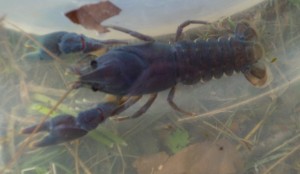Conserving the White-clawed Crayfish: Is it too late?
The white-clawed crayfish, Austropotamobius pallipes, is the only native crayfish species in the UK and unfortunately it is very much under threat from invasive species, disease and changes to water quality. Is it too late for them?
The answer is NO.
Although a slightly different approach to the conservation of white-clawed crayfish must be taken than to other species. The normal approach to conserving a species is through connectivity of populations but with white-clawed crayfish a new approach of creating ark sites or unconnected populations look to be the most likely way prevent the extinction of the species. As with all conservation projects education has a key role so the people understand the plight of the species.
White-clawed crayfish are under threat in the UK due to a mixed of ignorance, poor policy and malicious intent. These factors have caused the introduction and spread of signal crayfish along with other potential more invasive species of crayfish, such as red swamp or virile crayfish.
Signal crayfish were introduced to the UK in the 1970 in aquaculture trials although they were known from their introduction in Sweden to be highly invasive and to carry crayfish plague. The trade in crayfish in the UK never really took off, but the animals remained. If left to their own devices the spread of signal crayfish across the UK would take centuries as they move relatively slowly through the river system. This, however, is not the case as the animals are still being illegally introduced to new areas. This is known to have happen through naivety but also through malicious intent. To release or allow the escape into the wild of these or any non-native species of crayfish is illegal under the Wildlife and Countryside Act 1981. An excellent five day course I recently attended highlighted these issues as well as giving me an excellent grounding in crayfish surveys.
In recent years the spread of signal crayfish has been worsened by celebrity chefs promoting signal crayfish as a food source. Personally I would not eat signal crayfish primarily for the reason that they are a lot of faffing around for very little in return, as you can only eat the tail and the claws on some larger males; – also if you catch ones are too small to eat you can’t throw them back but have to kill them too. You also need a licence to fish for the animals. Another reason is if your crayfish trap is not set up correctly you may trap water voles and otters. Then I would seriously consider whether they are safe to eat. Although our rivers are cleaner than they once were very little work has been done on the bioaccumulation of heavy metals in signal crayfish but in Europe other species studies have shown that the noble crayfish does accumulate a considerable amount of heavy metals in organs and tissues.
Signal crayfish also carry crayfish plague, which is… which has decimated the white-clawed crayfish as they are believed to be 100% susceptible to it and when it reaches a white-clawed crayfish population it will kill all the crayfish in that stretch of the river.
Alarming recent work on signal crayfish is starting to show that the presence of signal crayfish is not only impacting on white-clawed crayfish, or having an economic effect on restoring waterways with signal crayfish but also that they pose a threat to game fisheries. It is being found that the spawning success of salmonids is reduced in headwaters where signal crayfish have been introduced .
It is not all doom and gloom – we can do something! Help to get the sale of crayfish banned in the UK, this is a start. If you are an angler ensure your equipment such as nets and boots are clean, dried in the sun and even disinfected to prevent the accidental spread of crayfish or crayfish plague. If we don’t actively spread crayfish plague or the non-native species this should allow us the time needed to find a solution to the problems they cause and prevent the extinction of a species.
John

